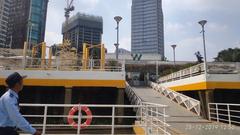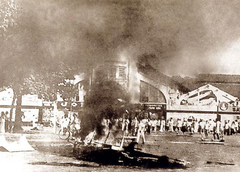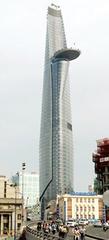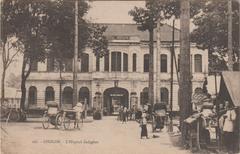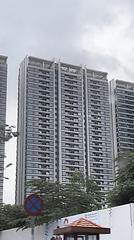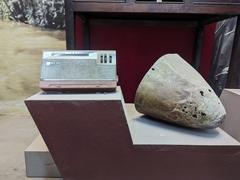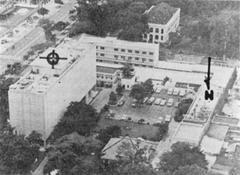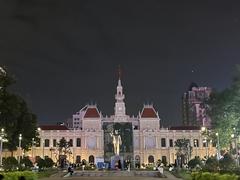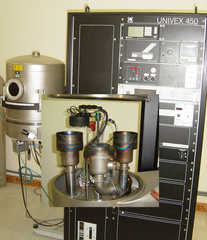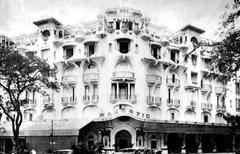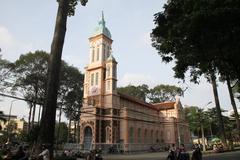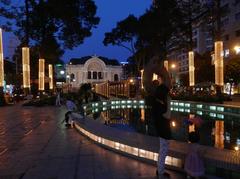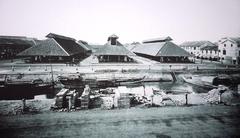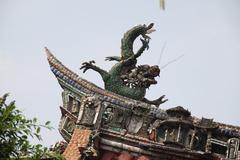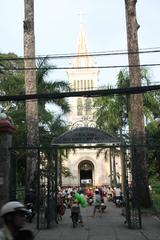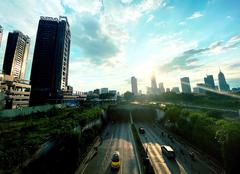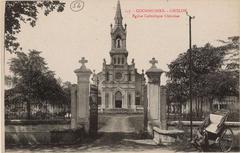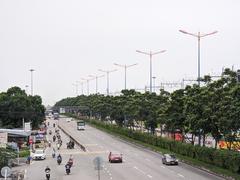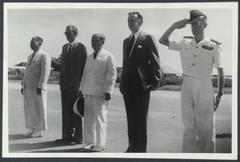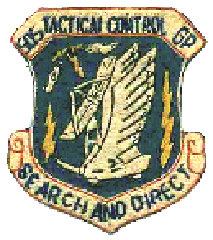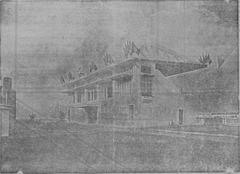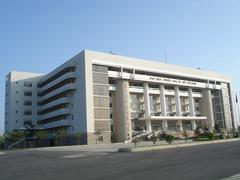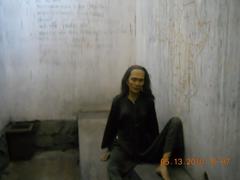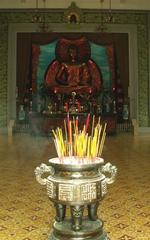
Mong Bridge Ho Chi Minh City: Visiting Hours, Tickets, and Historical Sites Guide
Date: 04/07/2025
Introduction
Mong Bridge (Cầu Mống) is a striking steel arch bridge that has become an enduring symbol of Ho Chi Minh City’s colonial heritage and vibrant contemporary life. Built between 1893 and 1894 by the renowned French engineering company Levallois Perret—also credited with the Eiffel Tower’s ironwork—Mong Bridge elegantly spans the Ben Nghe Canal, connecting District 1 and District 4. Its distinctive blue-green arch, graceful silhouette, and storied past make it one of the city’s most photogenic and meaningful urban landmarks (iTour Vietnam; VnExpress).
This guide offers a comprehensive look at Mong Bridge, including its historical significance, architectural features, practical visitor information, nearby attractions, and cultural relevance—helping you make the most of your visit to one of Ho Chi Minh City’s cherished historical sites.
Table of Contents
- Introduction
- Historical Overview
- Architectural Highlights and Restoration
- Visiting Hours, Tickets, and Accessibility
- Nearby Attractions and Guided Tours
- Cultural Significance and Social Life
- Practical Visitor Tips
- Frequently Asked Questions (FAQ)
- Conclusion & Recommendations
- References
Historical Overview
Mong Bridge was constructed during the French colonial era to facilitate movement between the administrative heart of Saigon and the bustling port areas of District 4. Its steel arch design, conceived by Levallois Perret, embodies late 19th-century French engineering excellence. Over the decades, Mong Bridge has witnessed pivotal moments in Vietnam’s history, including wartime upheavals and the city’s transformation from colonial Saigon to dynamic Ho Chi Minh City (vinwonders.com; Trek Zone).
Originally accommodating both pedestrians and vehicles, Mong Bridge has adapted to changing urban needs. In 2005, the bridge was temporarily dismantled to make way for the Saigon River Tunnel project and was later meticulously restored using original materials. It now serves exclusively as a pedestrian and cycling promenade, preserving its historical integrity while enhancing public access.
Architectural Highlights and Restoration
- Length and Structure: Mong Bridge stretches approximately 128 meters in length and 5.2 meters in width. Its elegant steel arch and riveted joints showcase the industrial artistry of its time.
- Design Features: The bridge’s single-span arch allows for unobstructed canal navigation beneath, while its decorative iron railings add a touch of French colonial grace.
- Restoration: Following its temporary removal in 2005, the bridge was reconstructed with reinforced foundations and staircases at both ends, prioritizing pedestrian access while maintaining its historic character (VnExpress).
- Current Appearance: The bridge’s signature blue-green color, introduced during restoration, enhances its visibility and charm against the city skyline.
Visiting Hours, Tickets, and Accessibility
- Opening Hours: Mong Bridge is open 24/7, providing access at any time of day or night (Trek Zone).
- Tickets: Entry is free; no tickets are required.
- Accessibility: The bridge is accessible via staircases and gentle ramps at either end, accommodating pedestrians, cyclists, and visitors with mobility challenges.
- Best Times to Visit: Early mornings for tranquility and soft light, or late afternoons to evenings for vibrant energy and illuminated city views.
Nearby Attractions and Guided Tours
Mong Bridge’s central location makes it a perfect starting point for exploring several of Ho Chi Minh City’s top attractions:
- Bitexco Financial Tower: Modern city views from the observation deck (7-minute walk).
- Ben Thanh Market: Iconic for shopping and street food (14-minute walk).
- Saigon Opera House, Fine Arts Museum, Central Post Office, Independence Palace: All within a 10–25-minute walk (Trek Zone).
Numerous city walking tours include Mong Bridge, providing historical context and local insights. Consider booking a guided tour for a richer experience (Ahoy Vietnam).
Cultural Significance and Social Life
Symbolism and Heritage
Mong Bridge, also known as the “Rainbow Bridge” or “Love Bridge,” has been recognized as a municipal Architectural and Artistic Heritage Site. Its presence embodies Saigon’s blend of tradition and modernity, serving as a visual and symbolic link across the city’s evolving landscape (vinwonders.com; historicbridges.org).
Social Hub
The bridge’s pedestrian-only status has transformed it into a lively gathering place, frequented by locals for morning exercises, fishing, reading, and evening socializing. Couples, photographers, and artists are drawn to its romantic ambiance and panoramic views, especially at sunset and after dark when city lights reflect in the river. The area often features street vendors selling popular snacks and beverages (scootersaigontour.com; moitruongdulich.vn).
Cultural Events and Artistic Inspiration
Mong Bridge’s graceful structure is a favorite backdrop for wedding and graduation photos, and its unique lighting at night makes it a focal point for city festivals and artistic performances. The bridge is frequently referenced in local music, poetry, and visual art as a symbol of nostalgia and romance.
Practical Visitor Tips
- How to Get There: Located at 33 Bến Vân Đồn, District 4, the bridge is easily accessible on foot from District 1 or by taxi and public bus (Trek Zone FAQ).
- Amenities: While the bridge itself has no shops or restrooms, nearby districts offer abundant cafés, restaurants, and facilities.
- Safety: The area is well-patrolled and popular with locals and tourists. Exercise normal urban precautions, especially after dark.
- Photography: Bring a camera for the best shots at sunrise, sunset, or during city light reflections.
- Etiquette: Respect the peaceful atmosphere, avoid littering, and be considerate of those taking photos or relaxing on the bridge.
Frequently Asked Questions (FAQ)
Q: Is there an entrance fee to visit Mong Bridge?
A: No, the bridge is free for all visitors.
Q: What are Mong Bridge’s visiting hours?
A: It is open 24 hours a day, every day.
Q: Is the bridge wheelchair accessible?
A: Yes, gentle ramps and staircases make it accessible for most visitors with mobility needs.
Q: Are guided tours available?
A: Yes, many local operators include Mong Bridge in their historical walking and cycling tours.
Q: Are there public restrooms?
A: Not on the bridge itself, but nearby attractions and cafés offer facilities.
Q: What is the best time to visit?
A: Early morning for peace and photography; late afternoon/evening for vibrant social scenes and beautiful lighting.
Conclusion & Recommendations
Mong Bridge is more than a crossing—it’s a living piece of Ho Chi Minh City’s urban fabric. Its elegant French colonial design, rich history, and transformation into a pedestrian oasis capture the city’s dynamic spirit. Centrally located and freely accessible, it’s an essential stop for anyone interested in Saigon’s past and present.
Plan your visit to coincide with the soft hues of sunrise or the golden glow of sunset for the most captivating views. Pair your stroll across Mong Bridge with a walking tour of nearby attractions for a full day of cultural immersion.
Download the Audiala app for audio tours, expert tips, and updates on cultural events. Follow us on social media to stay inspired and discover more hidden gems throughout Ho Chi Minh City.
If you’re seeking a blend of history, architecture, and local life, Mong Bridge stands as a testament to the enduring charm and resilience of Saigon.
References
- Mong Bridge Visiting Hours: A Complete Guide to This Historic Ho Chi Minh City Landmark, 2024, iTour Vietnam (iTour Vietnam)
- Mong Bridge Ho Chi Minh City: Visiting Hours, History & Architectural Highlights, 2024, VnExpress (VnExpress)
- Mong Bridge Visiting Hours, Tickets, and Its Cultural Significance Among Ho Chi Minh City Historical Sites, 2024, vinwonders.com (vinwonders.com)
- Mong Bridge Ho Chi Minh City: Visiting Hours, Tickets, and Nearby Historical Sites, 2024, Trek Zone (Trek Zone)
- Mong Saigon’s Famous Ancient Bridge, 2024, Welcome to Saigon (Welcome to Saigon)




